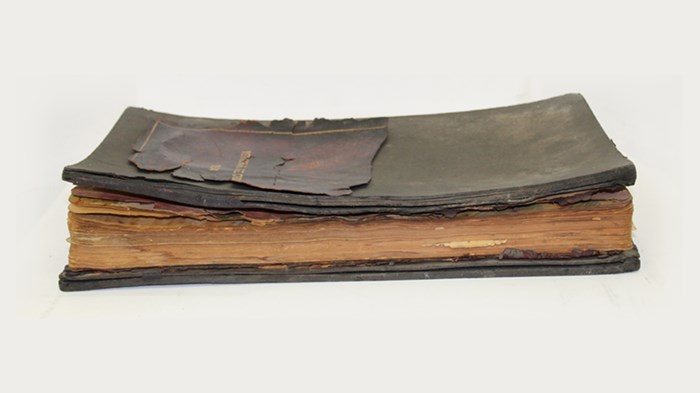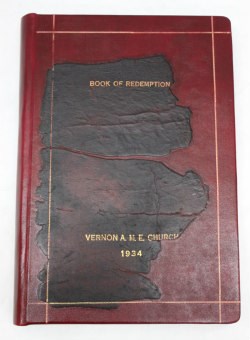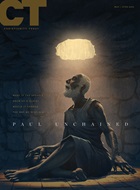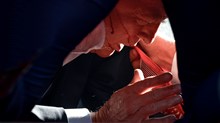
The book might look like it’s just a list of names and numbers, but Robert Richard Allen Turner, pastor of Vernon African Methodist Episcopal Church in Tulsa, Oklahoma, knows it’s more than that.
“It’s a ledger of our history that we still need to know today,” Turner said. “It’s a story of faith and folks who had faith in God.”
The city of Tulsa will pause on June 1 to remember the 100th anniversary of a racial massacre. In 1921, white Oklahomans killed hundreds of Black people and completely destroyed a prosperous Black community. When the violence ebbed, Greenwood Avenue—the heart of what was then called America’s Black Wall Street—was rubble. The mob had destroyed four hotels, two newspapers, eight doctor’s offices, seven barbershops, half a dozen real estate agencies, and half a dozen churches. One of the Black houses of worship that was damaged was the African Methodist Episcopal (AME) church, located then at 307 N. Greenwood.
The only thing left of the AME was the basement, and it too had been badly damaged. But the church decided to rebuild, and it kept a ledger of all the people who pledged to help and the money they contributed to the cause.
When Turner looks at that book, he thinks of the biblical genealogies and the Book of Numbers, where God told Moses to write down the names of the people who assisted him and to count and record the names of the people who had escaped bondage in Egypt and the descendants who went through the wilderness to the Promised Land.
“It’s not considered to be one of the sexier, more quoted [parts] of the Bible,” Turner said, “but the history of the genealogy in the Book of Numbers shows you the history of the people.”

What the Book of Numbers was to the Israelites, the Book of Redemption is to the congregation of Vernon AME Church.
When Turner took the position at Vernon, the book was old and decayed, though. He stuck it in a Tupperware container in an attempt to protect it from further damage. It might have stayed there if not for a special visit to the church on Juneteenth in 2020 by Oklahoma’s First Lady Sarah Stitt. During the tour, Turner showed Stitt the book and told her the story of the people whose names were written in it.
“She just immediately became overwhelmed by the story of faith of the individuals who had just lost their homes, just lost their businesses,” Turner said. “Some of them lost their loved ones and friends in the race massacre in 1921, but yet they came back to the church.”
The story stuck with Stitt, and she reached out to the Museum of the Bible to see if they could help Vernon restore the book.
The answer was yes. Anthony Schmidt, senior curator for the Museum of the Bible, said he and the staff at the Oklahoma City headquarters were instantly captivated by the story of the church and the Book of Redemption.
They met with Stitt and Turner in late July 2020 to discuss the project. In August, they began what would become an eight-month restoration project involving 15 people.
“It was in rough condition,” Schmidt said. “The cover was warped, and the leather that was originally on the cover had gone from a rich red to a brownish color, and it was flaking off and disintegrating.”
The binding for the book was torn in places, and some of the pages had tears and were falling out.
“When we first saw it, we knew this was going to take a little bit of time and a little bit of effort to restore it fully,” Schmidt said.
Conservator Francisco Rodriquez led the project: meticulously taking the book apart, repairing pages, cleaning mold, and stitching it back together again.
Turner had expressed his desire to see as much of the original preserved as possible, and Rodriguez did his best to honor that.
“What Francisco was able to do was save large portions of the original cover but also place them on top of a new leather cover that was close to the original color it would have looked like back in the 1930s,” Schmidt explained. “You get to see the cover that survived to today but also what it would have looked like back in the day.”
In addition to restoring the original, the Museum of the Bible made a replica so that people will be able to look at and study the book without handling the original and adding any more wear and tear.
“Generations to come will be able to look at this book and study it and learn about the history of this church,” Schmidt said.
Schmidt said he was personally touched when he read the donations listed in the book. Some donations are large for the time—$50 or $100. But other gifts are smaller—50 cents or a dollar. To him, those represent the biggest hearts.
“These were individuals who didn’t have a lot of money but they had a lot of faith and they had a lot of love for this community, and they wanted to see it rebuilt and wanted to see it thrive like it had,” he said. “That’s just inspiring.”
When Schmidt hears Turner speak of the work that the church is doing today, including raising money for feeding the hungry during the pandemic, he can’t help but think of the 360 names in the ledger and the families they represented.
“The hope and perseverance you see demonstrated in this ledger allowed the church to thrive and enabled it to serve the needs of the community for generations after,” he said.
Turner said he couldn’t be happier with the finished product and is grateful to be able to have it on display at the church for the 100th anniversary of the massacre on June 1 and for many years to come.

Support Our Work
Subscribe to CT for less than $4.25/month


















